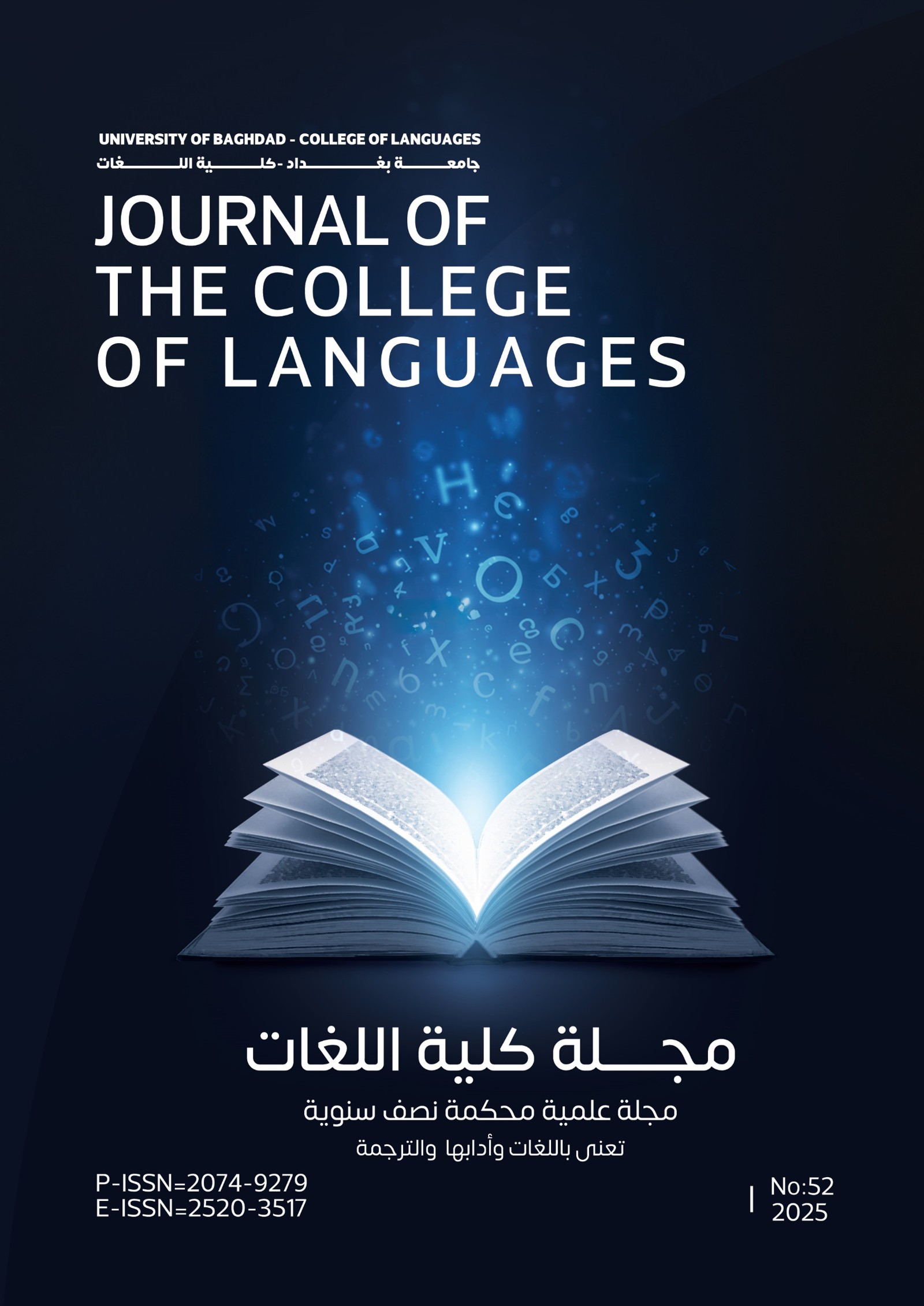The Effect of Genderism on the Process and the Product of Translation
DOI:
https://doi.org/10.36586/jcl.2.2022.0.45.0053Keywords:
Gender, Translator, Evaluator, Effect, BiasAbstract
Many studies have been made and still concerning the field of translation. Since the mid-90's a considerable amount of researches has tackled the problem of gender and its effect on the process and the product of translation. Simon (1996, p 508) points out that when comparing women and men as translators and writers through history, women seem to be the weaker side. This paves the way to feminist movements which produce prominent studies concerning gender as a concept and translator's gender as practice on the quality and the accuracy of the translation.
Flotow (in Meschia, 2012, p 1-4) outlines several issues that can be examined concerning gender and translation, these are historical studies, theoretical contemplations, translator's identity, post-colonial questions, and cultural questions. This research deals with two aspects of identity, i.e. gender: the gender of the translator (and its effect on the translation if there is any) and the gender of the evaluator of the translated text (and its effect if there is any).
The aim of this paper is to find out whether there is any negative influence of the identity on the process and the product of translation. For this purpose, 40 students from the Department of Translation at Al-Ma'moon College University, in addition to 20 postgraduate, have been asked to assess and analyze through a questionnaire (that tackles the identity of both translator and evaluator) and an assessment of Shakespeare's Sonnet (no. 18) and four translated versions of it.
The study remarkably shows that the gender-bias effect of the identity of the translator and the evaluator have an influence on students with 12.5% for undergraduate and 5% for postgraduate students. The majority of 87.5% and 95% believe that gender does not affect. This proves the research's hypothesis that there is a difference in the language of the two genders, yet it will not affect the gender of both of the translator and the evaluator.
(Received on 3/1/2021 - Accepted on 15/3/2021 - Published on 2/1/202)
References
Andone, Oana-Helena (2002). "Gender Issues in Translation". Perspectives: Studies in Translation Theory and Practice. 10 (2):135 – 150.
Basnett, Susan (2005). Translation Studies. Routledge. New York.
Brady, Amy (2018). How Emily Wilson Translated ‘The Odyssey’. The Epic’s First Female English Translator Examined the Gender Bias of Her Male Predecessors. The Chicago Review of Books Publication. Chicago.
Cameron, D. (1992). Feminism and Linguistic Theory. St. Martin's Press. New York.
Camus, C. & Castro, C. & Camus, J. (2017). Translation. Ideology and Gender. Cambridge Scholars Publishing. England. P. 195.
Candler-Hayes, Julie (2008). Translation, Subjectivity, and Culture in France and England, 1600-1800. 1st Edition. Stanford University Press. California.
Chamberlain, L. (1998). Gender Metaphoris in Translation. In M. Baker (Ed.) Encyclopedia of Translation Studies. Routledge. London. Pp. 93-96.
Coates, J. (2014). "Women, Men and Language (A Sociolinguistics Account of Gender Differences in Languages)". Retrieved on October 2020 from: https://www.researchgate.net/publication/287317822_Women_men_and_language_A_sociolinguistic_account_of_gender_differences_in_language_Third_edition
Colbran, S. (2002). Management Skills as a Criterion for Judicial Performance Evaluation. Retrieved on November from: www.austlii.edu.au/au/journals
Davis, Kathy (2007). The Making of Our Bodies, Ourselves. Duke University Press Books. North Carolina.
Eagly, H & Carli, L. (2003). "The Female Leadership Advantage: An Evaluation of the Evidence". The Leadership Quarterly. 14 (6).
Fairus, Rani & Fauzi, Asrizal (2017). "The Role of Gender in the Process Translation". Journal of Applied Linguistics and Language Research. 4 (4): 273-282.
Federici, Eleonora & Leonardi, Vanessa (2012). "Using and Abusing Gender in Translation: The Case of Virginia Woolf's "A Room of One's Own" Translated into Italian". Quaderns: Revista de Traduccio. 19: 183-198.
Ferrari, Pisana (2020). Does the Translator's Gender Influence the Interpretation of a Text? What Happens When Women Translate Classics? Retrieved on October 2020 from: https://www.capstan.be/does-the-translatrs-gender-influence-the-interpetation-of-a-text/
Flotow, Luise V. (1997). Translation and Gender: Translating in the 'Era of Feminism'. St. Jerome Publishing. Manchester.
--------------------- (2011). Translating Women. University of Ottawa Press. Ottawa.
--------------------- and Scott, Joan W. (2016). Connecting the Trans-disciplines: Translation Studies and Gender Studies. In Border Crossing: Translation Studies and Other Disciplines. John Benjamins Publication Company. Amsterdam, The Netherlands. Pp. 349-374.
Galavar, Ebrahim (2009). "The Effect of the Translator's Gender on Translation Evaluation". Translational Journal. 13 (2).
Gruber, H. (1991). Anti-Semitism in Media Discourse: The Waldheim Affairs in the Daily Press. German University Publisher. Germany. P. 195.
Hall, S. (1982). "The Rediscovery of Ideology: Return of the Repressed in Media Studies". In M. Gurevitch, T. Bennett, J. Curran and J. Woollacott (Eds.) Culture, Society and the Media. Methuen. London.
Harlitz-Kern, Erika (2020). "What happens when women translate classics". The Week. Issue: January 14, 2020. Retrieved from: https://theweek.com/artcles/87214/what-happens-when-women-translate-classics
Hatim, Basil and Mason, Ian (1990). Discourse and the Translator. Longman. London and New York. P. 161.
Hatim, Basil and Munday, Jeremy (2004). Translation: an Advanced Resource Book. Routledge. New York.
Holmes, J. (1995). Women, Men and Politeness. Longman. London and New York. P. 12.
Hsing, C.H. (2011). Gained in Translation: The Effect of Translators' Gender on English Language. New Castle University. England.
Jacob, Dan (2019). "Gender Bias and Sexism in Translation". Retrieved on October from: https://www.comtectranslations.co.uk/culture-localsation/gender-bias- sexism-in-transltion/
Karoubi, Behrouz (2020). "Gender and Translation". Retrieved on October from: https://www.transltiondrectory.com/article528
Leonardi, V. (2007). Gender and Ideology in Translation: Do Women and Men Translate Differently? A Contrastive Analysis from Italian into English. Peter Lang. Bern. P. 38.
Litosseliti, L. & Sunderland, J. (2002). Gender Identity and Discourse Analysis: Theoretical and Empirical Considerations. PA John Benjamins Publishing co. Philadelphia.
Livia, A. (2003). "One Man in Two is a Woman: Linguistic Approaches to Gender in Literary Texts". In Holmes & M. Meyerhoff (Ed.) The Handbook of Language and Gender. Blackwell Publishing. Oxford. P.p. 142-158.
Lunsford, L. (2000). "Ethical Judgments: Does Gender Matter?" Teaching Business Ethics. 4 (1).
Luthar, K. (2005). "Gender differences in evaluation of performance and leadership ability: Autocratic vs. democratic managers". Springer Netherlands. 35 (5-6).
Magyari-Vincze, Eniko (2002). Behind Translations as a Linguistic Issue: The Case of Romania. In The Making of European Women’s Studies: A work in progress report on curriculum development and related issues in gender education and research, Rosi Braidotti and Berteke Waaldijk (eds). Utrecht. Athena.
McElhinny, B. (2003). "Theorizing Gender in Sociolinguistics and Linguistics Anthropology". In Holmes & M. Meyerhoff (Ed.) The Handbook of Language and Gender. Blackwell Publishing. Oxford. P.p. 21 – 43.
Mehrez, Samia (2007). "Translating Gender between the Local and the Global". Journal of Middle East Women's Studies. Indiana University Press. 3 (1): 107 – 122.
Meschia, Karen (2012). "Luise Von Flotow (ed.), Translating Women". Miranda. Pp. 1- 4.
Moghaddas, Bahram (2013). "The Effect of Gender in Translation Accuracy of Iranian English Translators". International Journal of Management and Humanity Sciences. 2 (3).
Nissen, U. K. (2002). "Aspects of Translating Gender". Retrieved on November 2 from: http://www.lingustik-online.de/1102/nissen.html
Romaine, S. (1999). Communicating Gender. Lawrence Erlbaum Associates Publishers. London.
Pardo, B. Soler (2013). Translation Studies: An Introduction to History and Development of AudioVisual Translation. Villanueva de la Canada. Madrid.
Sapiro, Virginia (1981). "When are interests interesting? The problem of political representation of women". American Political Science Review 75 (3): 701-716.
Saragih, Amrin (2016). Variations and Functional Varieties of Language. State University of Medan. Medan.
Simon, S. (1996). Gender in Translation: Cultural Identity and the Politics of Transmission. In Maria S.C. de Borba's Review: Simon, Sherry, Gender in Translation - Cultural Identity and the Politics of Transmission. Universidade Federal de Santa Catarina. Brazil. P 508.
Stockwell, P. (2002). Sociolinguistics: A Resource Book for Students. Routledge. London and New York.
Talbot, M. (2003). "Gender Stereotypes: Reproduction and Challenge". In Holmes & M. Meyerhoff (Ed.) The Handbook of Language and Gender. Blackwell Publishing. Oxford. P.p. 468-486.
------------- (2010). Language and Gender. 2nd Edition.Polity Press. Malden.
Thompson, John B. (1984). Studies in the Theories of Ideology. Polity Press. Cambridge. P. 131.
Tsing, Anna (2005). Friction: An Ethnography of Global Connection. Princeton University Press. Princeton, N.J.
Waddington, C. (2001). "Different Methods of Evaluating Student Translation: The Question of Valdidity". Meta: XLVI (2): 311-325.
Wallmach, Kim (2006). "Feminist Translation Strategies: Different or Derived?" Journal of Literary Studies. 22 (1 – 2).
Wilson, Emily (2017). "First Woman to Translate Homer’s Odyssey Into English: How Modern Bias Is Projected Onto Antiquity". The Time. Issue: November 6, 2017. Retrieved from: https://theweek.com/articles/
Wodak, Ruth (1997). Introduction. In Wodak, R. (ed.) Gender and Discourse. Sage. London. Pp. 1-20.









